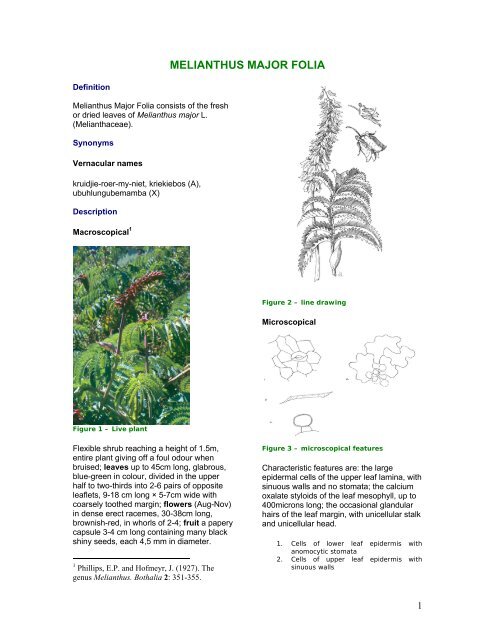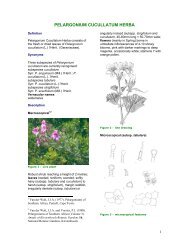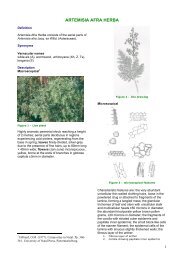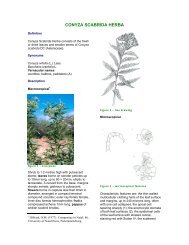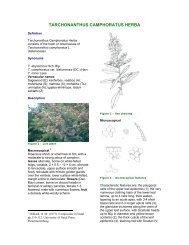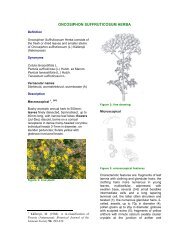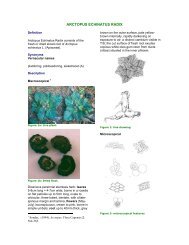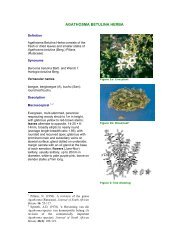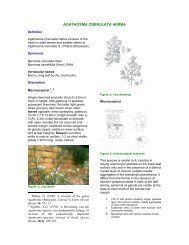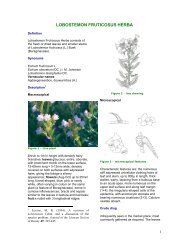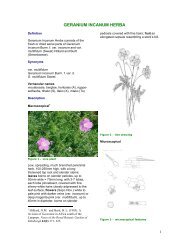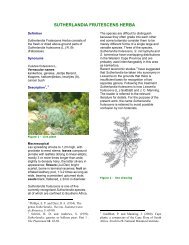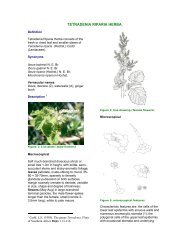MELIANTHUS MAJOR FOLIA - PlantZAfrica
MELIANTHUS MAJOR FOLIA - PlantZAfrica
MELIANTHUS MAJOR FOLIA - PlantZAfrica
You also want an ePaper? Increase the reach of your titles
YUMPU automatically turns print PDFs into web optimized ePapers that Google loves.
Definition<br />
Melianthus Major Folia consists of the fresh<br />
or dried leaves of Melianthus major L.<br />
(Melianthaceae).<br />
Synonyms<br />
Vernacular names<br />
kruidjie-roer-my-niet, kriekiebos (A),<br />
ubuhlungubemamba (X)<br />
Description<br />
Macroscopical 1<br />
Figure 1 – Live plant<br />
Flexible shrub reaching a height of 1.5m,<br />
entire plant giving off a foul odour when<br />
bruised; leaves up to 45cm long, glabrous,<br />
blue-green in colour, divided in the upper<br />
half to two-thirds into 2-6 pairs of opposite<br />
leaflets, 9-18 cm long × 5-7cm wide with<br />
coarsely toothed margin; flowers (Aug-Nov)<br />
in dense erect racemes, 30-38cm long,<br />
brownish-red, in whorls of 2-4; fruit a papery<br />
capsule 3-4 cm long containing many black<br />
shiny seeds, each 4,5 mm in diameter.<br />
1 Phillips, E.P. and Hofmeyr, J. (1927). The<br />
genus Melianthus. Bothalia 2: 351-355.<br />
<strong>MELIANTHUS</strong> <strong>MAJOR</strong> <strong>FOLIA</strong><br />
Figure 2 – line drawing<br />
Microscopical<br />
Figure 3 – microscopical features<br />
Characteristic features are: the large<br />
epidermal cells of the upper leaf lamina, with<br />
sinuous walls and no stomata; the calcium<br />
oxalate styloids of the leaf mesophyll, up to<br />
400microns long; the occasional glandular<br />
hairs of the leaf margin, with unicellular stalk<br />
and unicellular head.<br />
1. Cells of lower leaf epidermis with<br />
anomocytic stomata<br />
2. Cells of upper leaf epidermis with<br />
sinuous walls<br />
1
3. Calcium oxalate styloid from leaf<br />
mesophyll<br />
4. Glandular hair of leaf margin<br />
Crude drug<br />
Collected as required or found in the<br />
marketplace, usually as fresh leaf; colour<br />
blue green, texture smooth and pliable,<br />
odour characteristic unpleasant.<br />
Geographical distribution<br />
Figure 4 – distribution map<br />
Occurs in fynbos and karroo vegetation, in<br />
the Western and Eastern Cape Provinces,<br />
from Vanrhynsdorp south to the Cape<br />
Peninsula and eastwards to Port Elizabeth.<br />
Quality standards<br />
Identity tests<br />
Figure 5 – TLC plate<br />
Thin layer chromatography on silica gel<br />
using as solvent a mixture of toluene:diethyl<br />
ether:1.75M acetic acid (1:1:1). Reference<br />
compound cineole (0,1% in chloroform).<br />
Method according to Appendix 2a.<br />
Rf values of major compounds: 0,56<br />
(purple); cineole: 0,82 (blue-purple)<br />
HPLC on C18 column, method according to<br />
Appendix 2b.<br />
Major compounds:<br />
Figure 6 – HPLC spectrum<br />
Methanol extract: (Figure. 6)<br />
Retention times (mins): 15.66; 16.91; 17.99;<br />
18.76; 19.43<br />
Ethanol (70%) soluble extractive value:<br />
not less than 28,0% (range: 28.84-41.37%)<br />
Purity tests<br />
Assay<br />
Not yet available<br />
Figure 7 – chemical constituents<br />
2
Major chemical constituents<br />
Microchemical tests in our laboratories<br />
indicated the presence of tannins and<br />
saponins but not of alkaloids nor of cardiac,<br />
cyanogenic or anthraquinone glycosides. A<br />
phytochemical analysis of the aerial parts of<br />
Melianthus major plants cultivated in India<br />
demonstrated the presence of the<br />
triterpenes cyclolaudenol, oleanolic acid,<br />
ursolic acid and quercetaroic-30-caffeate<br />
and the phytosterols β-sitosterol and<br />
daucosterol 2 .<br />
Dosage forms<br />
Preparations of this species are rarely used<br />
for other than external application, oral<br />
toxicity being almost universally<br />
acknowledged among traditional<br />
practitioners. A leaf infusion or paste is<br />
applied to the affected area as a lotion or<br />
dressing; a leaf decoction is used as a<br />
mouthwash or gargle and leaves may be<br />
placed in the bath as a hot soak.<br />
Medicinal uses<br />
Warm aqueous leaf infusions may be<br />
applied as a lotion to sores, ulcers or<br />
wounds that are slow to heal, including<br />
venereal sores; similar infusions may be<br />
used as a gargle or mouthwash for oral<br />
ulcers, disease of the gums or sore throat.<br />
Ringworm of the scalp is said to have been<br />
successfully treated with this herb. A leaf<br />
paste may be applied as a local dressing to<br />
the affected area. Melianthus major is often<br />
used in combination with Lobostemon<br />
fruticosus and Galenia africana in traditional<br />
practice.<br />
Pharmacology/bioactivity<br />
In vitro antimicrobial activity of aqueous leaf<br />
extracts of Melianthus major was observed<br />
against Candida albicans, Staphylococcus<br />
aureus and Mycobacterium smegmatis, in<br />
the concentrations used for disc assays in<br />
our laboratories. No activity was<br />
demonstrated against Pseudomonas<br />
aeruginosa.<br />
2 Agarwal, J.S. and Rastogi, R.P. (1976).<br />
Phytochemistry 15: 430-431.<br />
Contraindications<br />
None recorded. The use of preparations of<br />
this herb is nevertheless not recommended<br />
for children under six years.<br />
Adverse reactions<br />
None reported in association with external<br />
use. Should irritation of the skin or mucous<br />
membrane occur, treatment should be<br />
discontinued.<br />
Precautions<br />
The internal use of preparations of<br />
Melianthus major is not recommended.<br />
Allied species have been shown to contain<br />
cardiac glycosides (see Melianthus<br />
comosus) and animal studies confirm the<br />
oral toxicity of M. major (see general<br />
references 1).<br />
Dosage<br />
Dried (10-20g) or fresh (20g-40g) leaf is<br />
mixed with one litre of boiling water in a<br />
closed vessel and allowed to stand until the<br />
resultant infusion can be applied to the skin<br />
or oral mucosa without discomfort. Strain<br />
before use. If a dressing is required, a paste<br />
may be prepared from fresh leaf softened in<br />
a little vegetable oil with the aid of gentle<br />
heat. Apply to the affected area on clean lint<br />
or gauze.<br />
Copyright in this monograph resides with the authors, the South<br />
African National Biodiversity Institute, the South African Medical<br />
Research Council and the University of the Western Cape. It may<br />
not be reproduced in whole or in part without the written consent of<br />
the copyright holders.<br />
3


